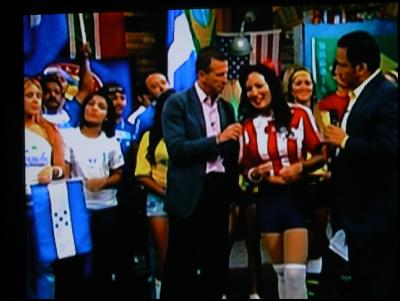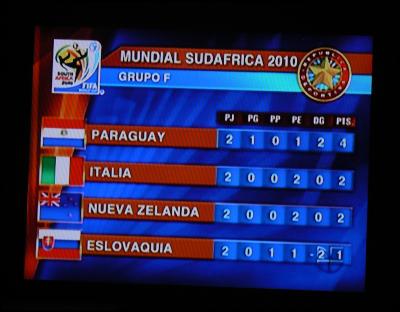Stateside: Eeeeeen Viiiiiiiiivo!
Eeeeeen Viiiiiiiiivo!
Luckily for me, one of the free-to-air Spanish-language channels in my area is carrying the FIFA World Cup live. There’s a double advantage to that: not being able to understand what the announcers are saying, I don’t get distracted by daft commentary; and it’s generally agreed in the US that the only way to watch soccer is in Spanish because futbol is so passionately loved in Latin America.
The Univision announcers even manage to draw the word “Live!” out for 30 seconds in a fever pitch of excitement before each game begins. So, I passed on going to watch the Italy-NZ game with the SFKiwis at a cafe in San Francisco’s Little Italy this morning to watch the game at home. That enabled me to clutch the cushion of my Barca lounger in a vice-like grip while repeating my mantra over and over again: Shut them out!
After that first goal, all the All Whites had to do was to stop Italy scoring, and if it hadn’t been for the penalty that Smith gave away in front of the goal and the mind-game played on the AW goalie, Italy would have lost. Then again, maybe the AW’s needed a mocking Italian gesture to get them to stay with the game plan. Whatever! A draw against the current cup holders was a bloody good result and I can walk into work on Monday morning with my head held high. Much to everyone’s surprise.
Univision’s pre-game coverage included the predictions of its resident psychic, a gentleman in dark glasses and gold-embroidered vest who scatters shells and reads the Tarot. There was a cutaway to an Italian family at Nelspruit who were asked to predict what the outcome would be: 5-0 to Italy. And just before the game began, the studio announcer in Joburg shuffled a deck of cards, threw them up in the air and, retaining one card, declared it also predicted a 5-0 victory to the current champions.
In the US, soccer is considered a youth sport, although there have been a couple of attempts to turn it into the cash cow that American football, baseball, basketball, and ice hockey have become. After his retirement, in 1975 Brazil’s “non-exportable national treasure” Pelé turned down a blank check to play in Mexico in order to play for the New York Cosmos because he was on a mission to popularize the sport in North America. The attention that he brought to the sport cemented its popularity with young players, but the NASL never really got off the ground financially, despite other teams in the league signing star foreign players in order to bring in the crowds.
The NASL’s failure was in large part due to one of the quirks of soccer history in the US. Its early popularity was founded among European immigrants, who worked six days a week, often at factories that also sponsored their team, so club games were always played on Sundays—the same day of the week that NASL scheduled its games. People simply preferred to play the game, or support their local ethnic team, than go and watch the professionals. As Stuart Murray says in his coaching book “Go for the Goal!”, team loyalty “is a cornerstone of ethnic-club soccer. Fan identification is the marketing term for it, and few NASL clubs were ever able to bottle it.”
By far the most interesting book I’ve read about club soccer is Franklin Foer’s “How Soccer Explains the World: an (unlikely) theory of globalization”. Foer, a political reporter, traveled the world visiting clubs like AC Milan, Red Star Belgrade, and FC Barcelona, to delve into the connections between politics and “the beautiful game”, as Pelé called it.
The book makes for some scary reading, especially the chapter about events leading up to the Balkans war in the 1990s and the overthrow of Slobodan Milosevic in 2000:
“Red Star fans like to say they were the agents of political change. ... At games, they sang ‘Kill yourself, Slobodan.’ To prevent protests, at one point, Milosevic’s regime allegedly began buying up tickets to national team matches and distributing them to friendly faces.”
On his own initiation into the world of soccer by his parents, at the age of eight in the early 80s, Foer writes:
“Quickly, soccer came to represent the fundamental tenets of yuppie parenting, the spirit of Sesame Street and Dr. Benjamin Spock. Unlike the other sports, it would foster self-esteem, minimize the pain of competition, while still teaching life lessons.” He adds that in the US the class structure of the game is inverted, compared to the rest of the world. “Surveys, done by the sporting goods manufacturers, consistently show that children of middle-class and affluent families play the game disproportionately.”
Jack Kemp, one of the most influential political conservatives of the 1980s “culture wars”, took to the House floor in 1986 to oppose a resolution supporting an American bid for the World Cup. Foer quotes Kemp (a former Buffalo Bills quarterback) as saying:
“I think it is important for all those young out there, who someday hope to play real football, where you throw it and kick it and run with it and put it in your hands, a distinction should be made that football is democratic, capitalism, whereas soccer is a European socialist [sport].”
Which helps you understand why the term “hockey mom” was such a potent meme in the 2008 presidential election: someone whose child plays a rough, competitive, and well-funded sport like ice hockey rather than soccer is obviously more in sync with American exceptionalism and capitalism than with namby-pamby values like self-esteem.
Frankly, I’m thankful that the North American Soccer League failed. I can’t even begin to imagine what a travesty commercial interests would have made of a game that relies on an uninterrupted flow of action. Good Lord! Only one ad-break in 90 minutes? How un-American is that!
(Good luck against Paraguay, guys! You’ve already made them very happy!)

Click to enlarge
--PEACE—



 Gordon Campbell: On Why The US Stands To Lose The Tariff Wars
Gordon Campbell: On Why The US Stands To Lose The Tariff Wars Eugene Doyle: Before It’s Too Late - Reimagine New Zealand’s Military Future
Eugene Doyle: Before It’s Too Late - Reimagine New Zealand’s Military Future  Binoy Kampmark: Gender Stunts In Space - Blue Origin’s Female Celebrity Envoys
Binoy Kampmark: Gender Stunts In Space - Blue Origin’s Female Celebrity Envoys Richard S. Ehrlich: A Deadly Earthquake & Chinese Construction
Richard S. Ehrlich: A Deadly Earthquake & Chinese Construction Ian Powell: It Does Matter To Patients Whether They Are Operated In A Public Or Private Hospital
Ian Powell: It Does Matter To Patients Whether They Are Operated In A Public Or Private Hospital Gordon Campbell: On Marketing The Military Threat Posed By China
Gordon Campbell: On Marketing The Military Threat Posed By China